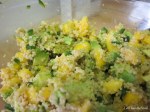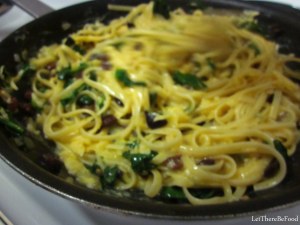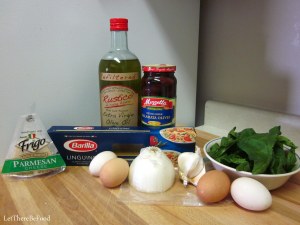I’m a little addicted to the combination of avocado and mango. Of all the things in the world to be addicted to, I suppose it’s really not all that bad, and certainly it benefits you, my foodie reader-eater. I’d never eaten the combination before until a visit to a family-owned restaurant in San Antonio called Pam’s. Before then, I wasn’t even sure I liked mangoes, to be honest. But after this visit, I was all in, hook, line, and sinker. Avocado and mango just seem to complement each other very well, and together they can take a fair bit of spicy heat which I also appreciate. With my addiction in mind, in the summer months, I’m always looking for ways to combine the two flavors. After reading some other blog posts on easy summer salads, I thought I could most certainly make a variation on a couscous salad with mango and avocado. The best news is that it can be done in just the time it takes for the couscous to cook! A five-minute dish? Why yes, please, and thank you!
Ingredients
1 small avocado
2 Ataulfo mangoes or 1 med-large mango of the larger varieties (I tend to use the larger varieties)
1 medium jalapeño
1 serving of couscous (1/3 cup dried couscous)
Steps
1. Prepare your couscous according to box directions.
2. Dice and seed your jalapeño. Some jalapeños are naturally just hotter than others, but you can control most of the heat by seeding the pepper and cutting out the ribs, or membranes, along the sides. I usually go with a small dice. Put into a bowl that can ultimately handle all your ingredients.
3. Dice your mango. I recommend slicing your mango sides off, which will be just shy of where the pit is. Take each half and cut through the flesh lengthwise, but not through the skin, then rotate it 45 degrees to slice across the width without going through the skin, which will create cubes. Pop the center up and you can slice the cubes off. Add to your bowl.




4. Dice your avocado. I use a similar method of slicing through the flesh lengthwise, then widthwise, to have cubes inside the skin of the avocado. To get the cubes out, I gently squeeze the avocado half around in my hand to loosen everything up, then take a spoon and run it around the edges to scoop them out. However, wait until after you add the couscous to add the avocado.

5. When your couscous is finished, fluff it and let it cool for a minute. Add it to the mango and pepper. Stir.
6. Add your avocado, and stir ever so gently so it doesn’t smash up. You want to keep the cubes intact.

7. Taste for seasoning, and add salt if you want or some chopped cilantro like I did!
I’m not entirely certain the kind of mango I use because my grocery store seems to only label Ataulfo mangoes. A Google search turned up several results on mangoes with pictures. However the pictures of the other variations of mangoes look VERY similar to me so I am not sure. The mangoes I use are large, green, red, sometimes yellow, usually kind of firm, and not so fibrous. Either way, I’m certain it will be tasty.
Please remember to be quite careful after handling the pepper. Wash your hands immediately so you don’t transfer the capsaicin oil to your face or other body parts. Ouch! I’ve heard that Cutty Sark (Blended Scotch Whiskey, of all things!) works well to take the sting out if you forget and touch your mouth or nose. This is according to my friend Erin D. I believe she speaks from experience. Sometimes, I will make a paste with baking soda, a touch of dish soap, and water to wash my hands. That helps remove the oil, I think. Using an acid, such as lemon juice or vinegar, might also help to get the oil off. Alton Brown recommends using plastic gloves, and I have followed that practice on and off through the years.
I haven’t had a chance to try these ideas yet, but here are several variations I’m considering. A finely diced red bell pepper would be a fine addition to this salad as would a minced red onion. I wouldn’t put in a ton of either ingredient because they can be powerfully strong ingredients. Green onion, both the green and the white parts, would work well. Garlic would be a fine addition as might a drizzle of balsamic vinegar. Go easy on the vinegar, though. A little goes a long way. You could also substitute quinoa or rice for the couscous; it will just take longer to cook for both of those. Who doesn’t love a recipe that has so many experimental possibilities?! I think it’s so fantastic, myself. It’s also nice in the summer that it’s quick and doesn’t heat up your kitchen that much.
Tell me what your favorite summer salad combinations are! I’d love to try something new. I hope you enjoy sweet and spicy couscous as much as I do. It’s been on repeat in my kitchen several times this summer already. I’m sure it will be on the regular rotation until the ingredients no longer make sense for the season. Happy eating!!
Approximate Nutritional information: Makes 2 generous servings or 3 reasonable servings. Information is for 3 servings.
Calories: 234.5
Fat: 10.7 g
Carbs: 34.3 g
Protein: 5 g
Potassium: 473.4 mg
Vitamin C: 64.7%
Filed under: Fruit, Meatless, Side Dishes, Vegetarian | Tagged: avocado, couscous, jalapeno, mango, salad, seasonal eating, summer salad, vegetarian | 2 Comments »























